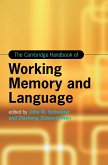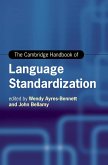The Cambridge Handbook of Task-Based Language Teaching
Herausgeber: Ahmadian, Mohammad Javad; Long, Michael H.
The Cambridge Handbook of Task-Based Language Teaching
Herausgeber: Ahmadian, Mohammad Javad; Long, Michael H.
- Broschiertes Buch
- Merkliste
- Auf die Merkliste
- Bewerten Bewerten
- Teilen
- Produkt teilen
- Produkterinnerung
- Produkterinnerung
Written by leading international experts, this handbook provides an accessible resource to task-based language teaching for teachers, as well as academic researchers. Chapters in the volume are presented in a reader-friendly style, with ideas made accessible through case studies, questions for discussion, and suggested further readings.
Andere Kunden interessierten sich auch für
![The Cambridge Handbook of Task-Based Language Teaching The Cambridge Handbook of Task-Based Language Teaching]() The Cambridge Handbook of Task-Based Language Teaching181,99 €
The Cambridge Handbook of Task-Based Language Teaching181,99 €![The Cambridge Handbook of Corrective Feedback in Second Language Learning and Teaching The Cambridge Handbook of Corrective Feedback in Second Language Learning and Teaching]() The Cambridge Handbook of Corrective Feedback in Second Language Learning and Teaching49,99 €
The Cambridge Handbook of Corrective Feedback in Second Language Learning and Teaching49,99 €![The Cambridge Handbook of Working Memory and Language The Cambridge Handbook of Working Memory and Language]() The Cambridge Handbook of Working Memory and Language51,99 €
The Cambridge Handbook of Working Memory and Language51,99 €![The Cambridge Handbook of Working Memory and Language The Cambridge Handbook of Working Memory and Language]() The Cambridge Handbook of Working Memory and Language151,99 €
The Cambridge Handbook of Working Memory and Language151,99 €![The Cambridge Handbook of Language Standardization The Cambridge Handbook of Language Standardization]() The Cambridge Handbook of Language Standardization157,99 €
The Cambridge Handbook of Language Standardization157,99 €![The Cambridge Handbook of Language Standardization The Cambridge Handbook of Language Standardization]() The Cambridge Handbook of Language Standardization49,99 €
The Cambridge Handbook of Language Standardization49,99 €![The Cambridge Handbook of Corrective Feedback in Second Language Learning and Teaching The Cambridge Handbook of Corrective Feedback in Second Language Learning and Teaching]() The Cambridge Handbook of Corrective Feedback in Second Language Learning and Teaching197,99 €
The Cambridge Handbook of Corrective Feedback in Second Language Learning and Teaching197,99 €-
-
-
Written by leading international experts, this handbook provides an accessible resource to task-based language teaching for teachers, as well as academic researchers. Chapters in the volume are presented in a reader-friendly style, with ideas made accessible through case studies, questions for discussion, and suggested further readings.
Hinweis: Dieser Artikel kann nur an eine deutsche Lieferadresse ausgeliefert werden.
Hinweis: Dieser Artikel kann nur an eine deutsche Lieferadresse ausgeliefert werden.
Produktdetails
- Produktdetails
- Cambridge Handbooks in Language and Linguistics
- Verlag: Cambridge University Press
- Seitenzahl: 710
- Erscheinungstermin: 13. Juni 2024
- Englisch
- Abmessung: 244mm x 170mm x 38mm
- Gewicht: 1188g
- ISBN-13: 9781108811934
- ISBN-10: 1108811930
- Artikelnr.: 70771168
- Herstellerkennzeichnung
- Libri GmbH
- Europaallee 1
- 36244 Bad Hersfeld
- gpsr@libri.de
- Cambridge Handbooks in Language and Linguistics
- Verlag: Cambridge University Press
- Seitenzahl: 710
- Erscheinungstermin: 13. Juni 2024
- Englisch
- Abmessung: 244mm x 170mm x 38mm
- Gewicht: 1188g
- ISBN-13: 9781108811934
- ISBN-10: 1108811930
- Artikelnr.: 70771168
- Herstellerkennzeichnung
- Libri GmbH
- Europaallee 1
- 36244 Bad Hersfeld
- gpsr@libri.de
Preface; Part I. The Rationale for TBLT: 1. The (unsatisfactory) status quo
in language teaching: a psycholinguistic rationale for TBLT; 2. A pedagogic
rationale for TBLT; Part II. Tasks and Needs Analysis: 3. Why tasks? Task
as the unit of analysis in language education; 4. Adapting and advancing
task-based needs analysis (NA) methodology across diverse language learning
contexts; 4A. Developing a task-based approach: a case study of Australian
Aboriginal VET students; 4B. A needs analysis for Syrian refugees in
Turkey; 4C. TBLT in a Japanese university: from needs analysis to
evaluation; 4D. The implementation of a task-based Spanish language program
in Qingdao, China: a case study; 5. The L in TBLT: analyzing target
discourse; 5A. Blustery with an occasional downpour: an analysis of target
discourse in media weather forecasts; 5B. 'I have a question': A
corpus-based analysis of target discourse in office hour interactions; Part
III. The Task Syllabus and Materials: 6. The Cognition Hypothesis, the
Triadic Componential Framework and the SSARC Model: an instructional design
theory of pedagogic task sequencing; 7. From needs analysis to task
selection, design, and sequencing; 7A. Task-based telecollaborative
exchanges between US and Italian students: a case study in program design
and implementation; 8. Exploring the nuts and bolts of task design; 8A.
Designing pedagogic tasks for refugees learning English to enter
universities in the Netherlands; Part IV. Methodology and Pedagogy: 9. A
psycholinguistically motivated methodology for TBLT; 10.
Technology-mediated TBLT; 10A. Task-based simulations for diplomatic
security agents; 10B. Delivering TBLT at scale: a case study of a
needs-based, technology-mediated workplace English program; 10C. TBLT and
Indigenous Language Revitalisation; Part V. TBLT with School-age Children:
11. Children interacting in task-supported EFL/CLIL contexts; 11A. Tasks
for children: using mainstream content to learn a language; 11B. A case
study of a task-based approach for school-age learners in China; Part VI.
The Teacher in TBLT: 12. Teacher preparation and support for TBLT; 12A.
Connecting teacher training to TBLT implementation: a case study of
pre-service teachers in Honduran bilingual schools; 12B. Training for tasks
the cooperative way: an online tutored TBLT course for teachers, managers
and course designers; Part VII. Task-Based Assessment and Program
Evaluation: 13. Task-based, criterion-referenced performance testing; 14.
TBLT program evaluation: why and how; 14A. Comparing the effectiveness of
TBLT and PPP on L2 grammar learning: a pilot study with Chinese students of
Italian L2; 14B. Evaluating the pilot year of a task-based Spanish
immersion camp for high schoolers: examining learners' experience of task
motivation and difficulty within and following tasks; 14C. Designing a
classroom-based TBLA framework for primary schools: blurring the lines
between teaching, learning and assessment; Part VIII. Research Needs and
Future Prospects: 15. Methodological issues in (cognitively-oriented) TBLT
research: advances and challenges; 16. Innovation in language education: a
task-based perspective; 17. The adoption of TBLT in diverse contexts:
challenges and opportunities; Conclusion.
in language teaching: a psycholinguistic rationale for TBLT; 2. A pedagogic
rationale for TBLT; Part II. Tasks and Needs Analysis: 3. Why tasks? Task
as the unit of analysis in language education; 4. Adapting and advancing
task-based needs analysis (NA) methodology across diverse language learning
contexts; 4A. Developing a task-based approach: a case study of Australian
Aboriginal VET students; 4B. A needs analysis for Syrian refugees in
Turkey; 4C. TBLT in a Japanese university: from needs analysis to
evaluation; 4D. The implementation of a task-based Spanish language program
in Qingdao, China: a case study; 5. The L in TBLT: analyzing target
discourse; 5A. Blustery with an occasional downpour: an analysis of target
discourse in media weather forecasts; 5B. 'I have a question': A
corpus-based analysis of target discourse in office hour interactions; Part
III. The Task Syllabus and Materials: 6. The Cognition Hypothesis, the
Triadic Componential Framework and the SSARC Model: an instructional design
theory of pedagogic task sequencing; 7. From needs analysis to task
selection, design, and sequencing; 7A. Task-based telecollaborative
exchanges between US and Italian students: a case study in program design
and implementation; 8. Exploring the nuts and bolts of task design; 8A.
Designing pedagogic tasks for refugees learning English to enter
universities in the Netherlands; Part IV. Methodology and Pedagogy: 9. A
psycholinguistically motivated methodology for TBLT; 10.
Technology-mediated TBLT; 10A. Task-based simulations for diplomatic
security agents; 10B. Delivering TBLT at scale: a case study of a
needs-based, technology-mediated workplace English program; 10C. TBLT and
Indigenous Language Revitalisation; Part V. TBLT with School-age Children:
11. Children interacting in task-supported EFL/CLIL contexts; 11A. Tasks
for children: using mainstream content to learn a language; 11B. A case
study of a task-based approach for school-age learners in China; Part VI.
The Teacher in TBLT: 12. Teacher preparation and support for TBLT; 12A.
Connecting teacher training to TBLT implementation: a case study of
pre-service teachers in Honduran bilingual schools; 12B. Training for tasks
the cooperative way: an online tutored TBLT course for teachers, managers
and course designers; Part VII. Task-Based Assessment and Program
Evaluation: 13. Task-based, criterion-referenced performance testing; 14.
TBLT program evaluation: why and how; 14A. Comparing the effectiveness of
TBLT and PPP on L2 grammar learning: a pilot study with Chinese students of
Italian L2; 14B. Evaluating the pilot year of a task-based Spanish
immersion camp for high schoolers: examining learners' experience of task
motivation and difficulty within and following tasks; 14C. Designing a
classroom-based TBLA framework for primary schools: blurring the lines
between teaching, learning and assessment; Part VIII. Research Needs and
Future Prospects: 15. Methodological issues in (cognitively-oriented) TBLT
research: advances and challenges; 16. Innovation in language education: a
task-based perspective; 17. The adoption of TBLT in diverse contexts:
challenges and opportunities; Conclusion.
Preface; Part I. The Rationale for TBLT: 1. The (unsatisfactory) status quo
in language teaching: a psycholinguistic rationale for TBLT; 2. A pedagogic
rationale for TBLT; Part II. Tasks and Needs Analysis: 3. Why tasks? Task
as the unit of analysis in language education; 4. Adapting and advancing
task-based needs analysis (NA) methodology across diverse language learning
contexts; 4A. Developing a task-based approach: a case study of Australian
Aboriginal VET students; 4B. A needs analysis for Syrian refugees in
Turkey; 4C. TBLT in a Japanese university: from needs analysis to
evaluation; 4D. The implementation of a task-based Spanish language program
in Qingdao, China: a case study; 5. The L in TBLT: analyzing target
discourse; 5A. Blustery with an occasional downpour: an analysis of target
discourse in media weather forecasts; 5B. 'I have a question': A
corpus-based analysis of target discourse in office hour interactions; Part
III. The Task Syllabus and Materials: 6. The Cognition Hypothesis, the
Triadic Componential Framework and the SSARC Model: an instructional design
theory of pedagogic task sequencing; 7. From needs analysis to task
selection, design, and sequencing; 7A. Task-based telecollaborative
exchanges between US and Italian students: a case study in program design
and implementation; 8. Exploring the nuts and bolts of task design; 8A.
Designing pedagogic tasks for refugees learning English to enter
universities in the Netherlands; Part IV. Methodology and Pedagogy: 9. A
psycholinguistically motivated methodology for TBLT; 10.
Technology-mediated TBLT; 10A. Task-based simulations for diplomatic
security agents; 10B. Delivering TBLT at scale: a case study of a
needs-based, technology-mediated workplace English program; 10C. TBLT and
Indigenous Language Revitalisation; Part V. TBLT with School-age Children:
11. Children interacting in task-supported EFL/CLIL contexts; 11A. Tasks
for children: using mainstream content to learn a language; 11B. A case
study of a task-based approach for school-age learners in China; Part VI.
The Teacher in TBLT: 12. Teacher preparation and support for TBLT; 12A.
Connecting teacher training to TBLT implementation: a case study of
pre-service teachers in Honduran bilingual schools; 12B. Training for tasks
the cooperative way: an online tutored TBLT course for teachers, managers
and course designers; Part VII. Task-Based Assessment and Program
Evaluation: 13. Task-based, criterion-referenced performance testing; 14.
TBLT program evaluation: why and how; 14A. Comparing the effectiveness of
TBLT and PPP on L2 grammar learning: a pilot study with Chinese students of
Italian L2; 14B. Evaluating the pilot year of a task-based Spanish
immersion camp for high schoolers: examining learners' experience of task
motivation and difficulty within and following tasks; 14C. Designing a
classroom-based TBLA framework for primary schools: blurring the lines
between teaching, learning and assessment; Part VIII. Research Needs and
Future Prospects: 15. Methodological issues in (cognitively-oriented) TBLT
research: advances and challenges; 16. Innovation in language education: a
task-based perspective; 17. The adoption of TBLT in diverse contexts:
challenges and opportunities; Conclusion.
in language teaching: a psycholinguistic rationale for TBLT; 2. A pedagogic
rationale for TBLT; Part II. Tasks and Needs Analysis: 3. Why tasks? Task
as the unit of analysis in language education; 4. Adapting and advancing
task-based needs analysis (NA) methodology across diverse language learning
contexts; 4A. Developing a task-based approach: a case study of Australian
Aboriginal VET students; 4B. A needs analysis for Syrian refugees in
Turkey; 4C. TBLT in a Japanese university: from needs analysis to
evaluation; 4D. The implementation of a task-based Spanish language program
in Qingdao, China: a case study; 5. The L in TBLT: analyzing target
discourse; 5A. Blustery with an occasional downpour: an analysis of target
discourse in media weather forecasts; 5B. 'I have a question': A
corpus-based analysis of target discourse in office hour interactions; Part
III. The Task Syllabus and Materials: 6. The Cognition Hypothesis, the
Triadic Componential Framework and the SSARC Model: an instructional design
theory of pedagogic task sequencing; 7. From needs analysis to task
selection, design, and sequencing; 7A. Task-based telecollaborative
exchanges between US and Italian students: a case study in program design
and implementation; 8. Exploring the nuts and bolts of task design; 8A.
Designing pedagogic tasks for refugees learning English to enter
universities in the Netherlands; Part IV. Methodology and Pedagogy: 9. A
psycholinguistically motivated methodology for TBLT; 10.
Technology-mediated TBLT; 10A. Task-based simulations for diplomatic
security agents; 10B. Delivering TBLT at scale: a case study of a
needs-based, technology-mediated workplace English program; 10C. TBLT and
Indigenous Language Revitalisation; Part V. TBLT with School-age Children:
11. Children interacting in task-supported EFL/CLIL contexts; 11A. Tasks
for children: using mainstream content to learn a language; 11B. A case
study of a task-based approach for school-age learners in China; Part VI.
The Teacher in TBLT: 12. Teacher preparation and support for TBLT; 12A.
Connecting teacher training to TBLT implementation: a case study of
pre-service teachers in Honduran bilingual schools; 12B. Training for tasks
the cooperative way: an online tutored TBLT course for teachers, managers
and course designers; Part VII. Task-Based Assessment and Program
Evaluation: 13. Task-based, criterion-referenced performance testing; 14.
TBLT program evaluation: why and how; 14A. Comparing the effectiveness of
TBLT and PPP on L2 grammar learning: a pilot study with Chinese students of
Italian L2; 14B. Evaluating the pilot year of a task-based Spanish
immersion camp for high schoolers: examining learners' experience of task
motivation and difficulty within and following tasks; 14C. Designing a
classroom-based TBLA framework for primary schools: blurring the lines
between teaching, learning and assessment; Part VIII. Research Needs and
Future Prospects: 15. Methodological issues in (cognitively-oriented) TBLT
research: advances and challenges; 16. Innovation in language education: a
task-based perspective; 17. The adoption of TBLT in diverse contexts:
challenges and opportunities; Conclusion.








